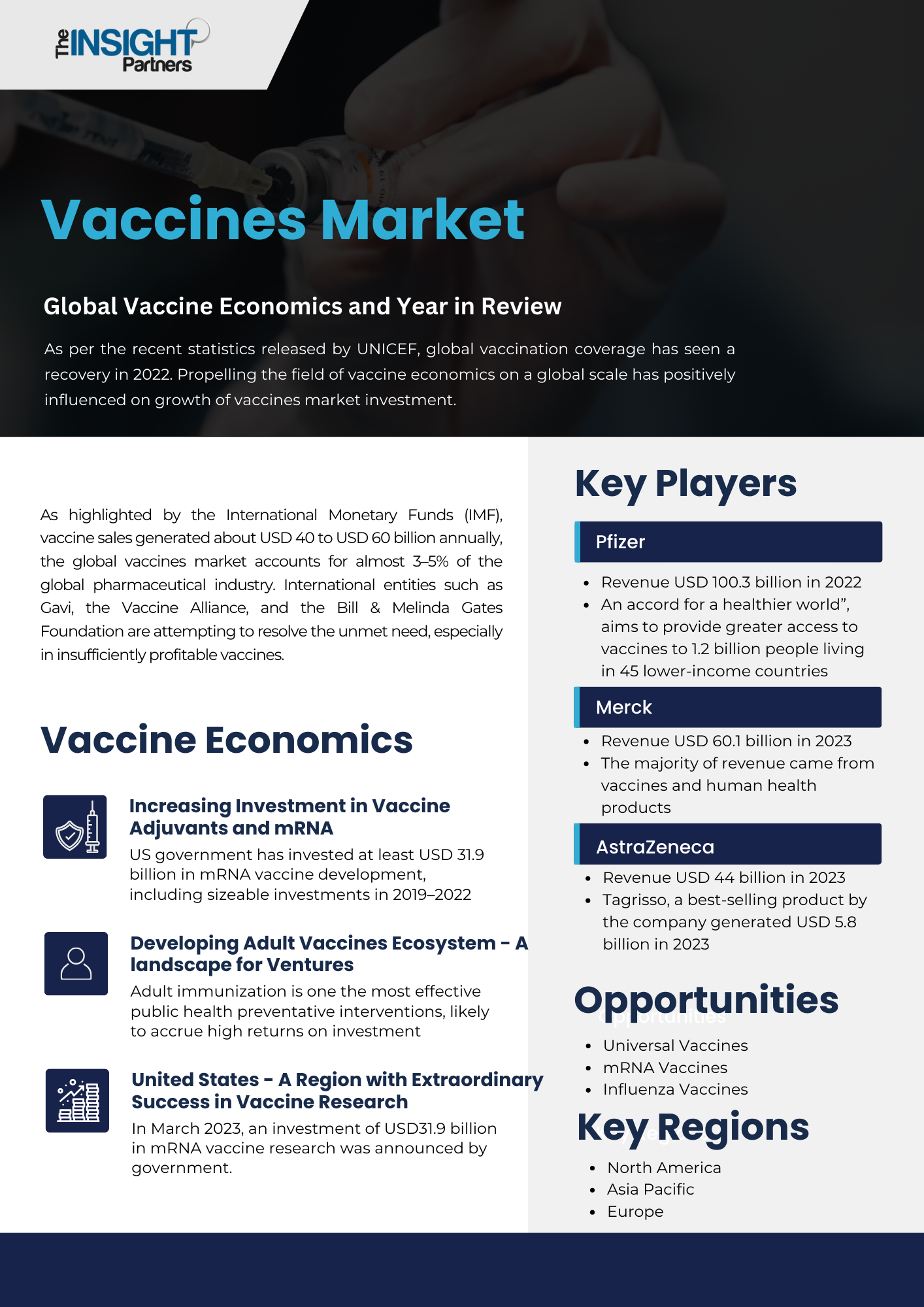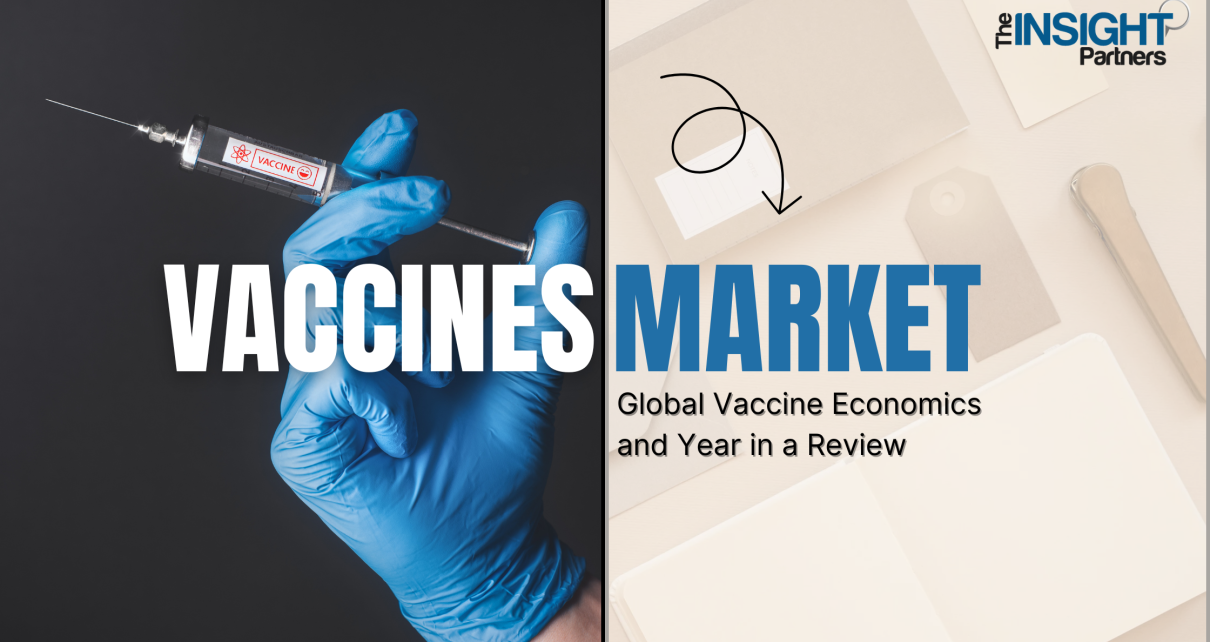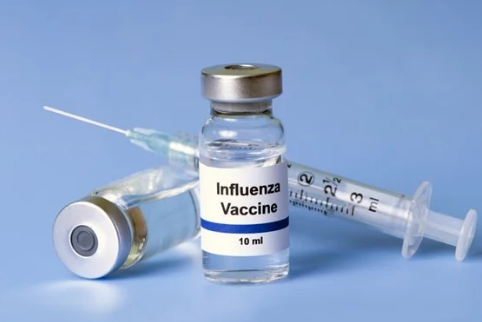Vaccines market has experienced incredible innovations with a profound public health impact. As per the recent statistics released by UNICEF, global vaccination coverage has seen a recovery in 2022, coverage of the third dose of vaccines protecting against diphtheria, and pertussis recovered to 84% in 2022. Further innovation in vaccine development is expected to introduce new vaccines market trends during the upcoming decade.
The WHO estimates that vaccines prevent 2–3 million deaths each year from pertussis, tetanus, influenza, and measles. Vaccine development has attracted lucrative investment as a response to increasing epidemic risk, drawing benefits for economies. Effective collaborations between private players, government and publicly funded universities, and for-profit pharmaceutical companies have favored expansion of vaccines market share. Propelling the field of vaccine economics on a global scale has positively influenced on growth of vaccines market investment.
In this blog, explore more about recent developments, opportunities, and some critical success determinants. Moreover, let’s dive deeper into the current status of the vaccines market and gauge the market growth for the future.
Increasing Investment And R&D in Vaccine Adjuvants and mRNA
Vaccine business is capital-intensive and requires considerable ongoing investment in manufacturing assets, people, compliance, and facilities. Consolidation of this industry is likely to propel through big market players in India, China, and Brazil. The US government has invested at least USD 31.9 billion in mRNA vaccine development, including sizeable investments in 2019–2022.
As highlighted by the International Monetary Funds (IMF), vaccine sales generated about USD 40 to USD 60 billion annually, the global vaccines market accounts for almost 3–5% of the global pharmaceutical industry. International entities such as Gavi, the Vaccine Alliance, and the Bill & Melinda Gates Foundation are attempting to resolve the unmet need, especially in insufficiently profitable vaccines.
The emergence of ground-breaking mRNA technology in vaccines offers a versatile ground for companies to attempt targeted vaccine development against viral outbreaks, emerging pathogens, and other infectious diseases. These mRNA vaccines are represented under a new class of vaccines harnessing the body’s cellular machinery to produce antigens.
Messenger RNA vaccine development for preventive and therapeutic applications has increased rapidly in recent years due to its proven efficiency in various applications including infectious disease, immunotherapy, regenerative medicine, genetic disorders, and cancer.
The current acceptance rate for vaccines in the USA is 56% to 75%. With many mRNA vaccines making it to clinical trials and a couple of them having gotten approvals so far, this segment is anticipated to remain lucrative for growth in the vaccines market.
Recent deployment of mRNA-based vaccines against the SARS-CoV-2 virus has garnered significant traction across the globe due to its advantages over traditional vaccines. Unlike traditional vaccines, mRNA-based vaccines can be quickly designed and synthesized. These vaccines are highly flexible and give speedy responses which has raised its adoption rate in recent years.
(2022-2023) Year in Review for Key Vaccines Market Players – Competitive Landscape
Pfizer
- Pfizer reported revenue of USD 100.3 billion in 2022. With more than 618 million patients treated with medicines and vaccines, Pfizer remains the dominant vaccines market player in 2023. The company has obtained approvals on new molecular entities.
- In December 2023, Pfizer completed the acquisition of Seagen for USD 229 per stock and a total enterprise value of USD 43 billion. As a part of the commitment under “An accord for a healthier world”, aims to provide greater access to vaccines to 1.2 billion people living in 45 lower-income countries around the globe.
Merck
- Merck’s revenue has increased in 2023, rising from 59.3 billion USD in 2022 to USD 60.1 billion in 2023. During 2021, the company has spun off established businesses in women’s health, biosimilars, and established brands into publicly traded company Organon & Co.
- The majority of company revenue came from pharmaceuticals which include vaccines and human health products. The company’s franchise in oncology generated the largest share of pharmaceutical sector revenues.
- The company has announced a collaboration with Daiichi Sankyo’s proven ADC expertise and DXd technology with Merck’s deep experience in clinical development. Merck’s oncology segment is expected to make 47% of USD 64 billion in total revenues in the company over the financial year 2024. It’s anticipated to remain the key source of revenue growth in the coming years.
AstraZeneca
- With a reported revenue of USD 44 billion in 2023, the company experienced significant growth in the sixth consecutive year. The largest therapeutic area responsibly driving a third of company revenue is oncology.
- Tagrisso, a best-selling product by the company generated USD 5.8 billion in 2023. Before COVID-19 company was not among the top vaccine manufacturers, the company initiated involvement in the area of vaccines and immune therapies after COVID-19. Other top products are Farxiga, Imfinzi, and Symbiocort.

Developing Adult Vaccines Ecosystem – Lucrative Landscape for Ventures
By 2030, the population above 60 is expected to increase by more than a third, to 1.4 billion. Adult immunization is one the most effective public health preventative interventions, likely to accrue high returns on investment at individual, economic, and societal levels.
The adult vaccine landscape is rapidly evolving as people globally may find themselves at a crossroads where addressing the status quo of immunization is no longer an option but a need. The Covid-19 pandemic has served as a stark wake-up call for healthcare experts as well as people. The global health crisis exposed the fragmented nature of adult vaccine infrastructure on domestic and international fronts.
Ongoing transformation in adult vaccines is anticipated to be accelerated by the rise of RNA technology. RNA-based solutions, in contrast to their conventional biologic equivalents, are not limited by the same manufacturing technique for different antigen sequences1. Rather, the RNA vaccine’s production method mostly stays the same, except for minor changes to the antigen sequence. This makes it possible to imagine creative vaccines designs that just require one manufacturing procedure.
United States – A Region with Extraordinary Success in Vaccine Research
The United States has been extraordinarily successful in vaccine research and development. Since the past 20 years, most new vaccines have been developed in this region. Acellular pertussis immunization has become more widely used as a result of the introduction of vaccine combinations that simplify childhood vaccination. Wyeth, a Pfizer subsidiary today, presented a polyvalent pneumococcal conjugate vaccination for newborns, which has gained widespread traction and elevated Pfizer to a prominent position in the vaccine industry.
There have been many new vaccines approved, such as the combined measles, mumps, and rubella (MMR) and varicella vaccine, plus new vaccines for rotavirus, herpes zoster, HPV, meningococcus, influenza, and more. The HPV vaccines from Merck and GlaxoSmithKline have greatly broadened the range of adolescent vaccines and showed that people are willing to pay more for them.
The US government announced support for vaccine manufacturers. For example, In March 2023, an investment of USD31.9 billion in mRNA vaccine research was announced by the government. Faster government approvals and vaccine development are drivers of the US vaccines market share.
Over the past decade, the vaccine industry in the United States and Europe has drastically enhanced its dependability as a provider. Gone are the days of persistent shortages; this transformation has mainly been brought about by updating vaccine production and distribution systems, which have been bolstered and financed by the success of the vaccines market.
Asia Pacific is expected to dominate in terms of high R&D spending by research organizations and publications. From state-owned, private players to contract research organizations investment in vaccine development has increased throughout the last decade. Countries in the Asia Pacific utilize supply and demand side approaches to incentivize vaccines market investment. High-income countries in Asia Pacific are major share holders and more collaborations are awaited along with the launch of vaccine development programs.
Beyond the Needle: Next Frontier for Vaccines Market
With greater emphasis on preventive health metrics, the vaccines market is poised to grow at a lucrative CAGR in the coming years. Countries have consistently improved expenditure on vaccine production and health outcomes. This is an indicator of sustained investment in vaccination for overall population health. In addition to more conventional methods like live attenuated or inactivated vaccinations, scientists are investigating new vaccine platforms. This includes vaccinations based on mRNA (like with COVID-19 vaccines), DNA, recombinant protein, viral vector, and nanoparticle technologies. These systems have benefits including scalability, quick development, and maybe wider pathogen protection.
“universal” vaccines have garnered traction of attention as they offer enduring defense against several strains or possibly entire families of viruses. This strategy might eliminate the need for yearly updates, as is the case with influenza vaccinations, and improve immunization efficacy while streamlining vaccination campaigns. With immense success, the US continues to dominate the vaccine landscape, while the APAC region will also remain a hub for vaccine research and development in the coming decade.
References
UNICEF – Immunization
NIHM – A Comprehensive Review of mRNA Vaccines
Pfizer – Annual Review 2023
NIHM (National Library of Medicine) – Trends in Vaccine Investment in Middle Income Countries



